| 1 | Mangshan pitviper |
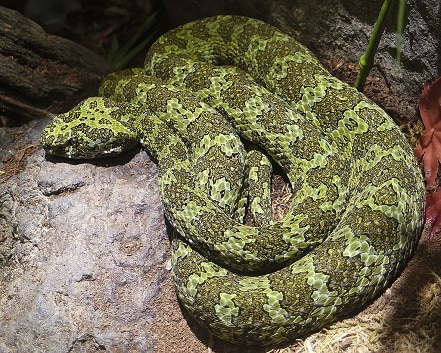
Snakes have evolved many skills over their 100 million years of existence. One that exists in only a few dozen is caudal luring – when snakes wiggle a colourful tail to tempt in prey, which mistake it for insects, and are then devoured.
One example is the Mangshan pitviper, a resident of mountain ranges and submontane tropical forests of southern China. The Mangshan pitviper is a slow and patient species all around, and deploys this patience for careful, mesmerising tail waggling. It lurks silently on moss-covered logs and boulders, blending in with its immense camouflage, amidst a constant chirping of insects and pitter-patter of rain.
If bitten by a Mangshan pitviper, the likely consequences are muscle tissue destruction and spontaneous bleeding. Attacks on humans are rare, and most locals know not to approach. The Mangshan pitviper’s tail meanwhile, is a bright white colour, contrasting sharply against their mossy green body. If waggled at just the right speed, this resembles an insect floating absentmindedly around the rainforest. The white is easily visible against the jungle, and is difficult to recognise as any snake a frog has stored in its memory banks. The small forest creature will approach eagerly, and if it fails to recognise the deception, be swallowed whole. Mangshan pitvipers prey on a mixture of mammals and frogs; in captivity they happily gobble up rats.
| 2 | Bothrops bilineatus |
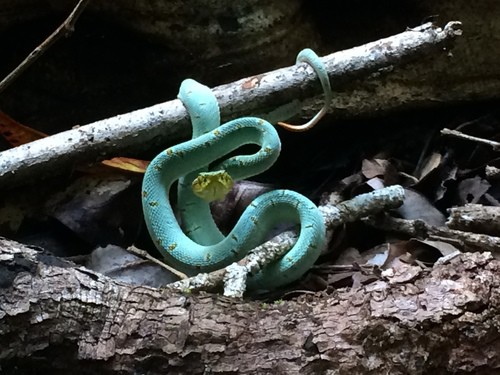
Many Bothrops pitvipers (such as jararacas) have bright tail tips as younglings. Before their venom reaches full potency, they need alternative prey luring strategies. But Bothrops bilineatus is one of the few to keep a colourful tail into adulthood and old age.
Despite a cytotoxic venom which tears through skin and muscle cells, rendering small frogs immobile, this Amazon species keeps caudal luring as a backup, a way to stack the cards ever further in their favour. This is the most branch-dwelling Bothrops, and many others on this list are also branch dwellers (maybe there’s a connection). Bothrops bilineatus can reach perches 20 metres above the forest floor, and eats prey such as red snouted treefrogs and Marmorea frog. They’re widespread across Brazil and cannot survive without forests.
Exactly what triggers a snake to start tail wagging is unknown, but we can make educated guesses. Sometimes, it might be a regularly scheduled probing wiggle, hoping to flush out prey which might be lurking out of sight. But they could also pick up a lizard’s scent in the air, realise they’re approaching, and then kickstart the process.
| 3 | Lesser Sunda pitviper |
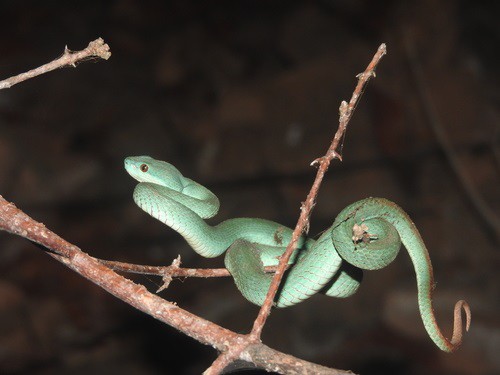
Another snake which doesn’t need caudal luring, as it possesses a corrosive cytotoxic venom, yet keeps its bright tail for the simple sake of being overpowered. Lesser Sunda pitviper venom is rich in metalloproteinases, and can cause swelling, necrosis and gangrene in humans. Small lizards don’t stand a chance.
However, this snake prefers to be more subtle, and starts by extending their tail, poking it away from their body. Then they begin slow, steady wiggling, in a rhythmical motion like a hypnotist’s chain. Lesser Sunda pitvipers vary in colour, with bright green and blue intermingling in the same population. However, the bright red tail is a constant feature.
The final piece of the caudal luring puzzle is a fast pounce. Lesser Sunda pitvipers stay still for many hours, but can explode into life when it’s finally go time. Dozens of scales suddenly shift at once, and the poor lizard is being rearranged for swallowing before it realises what’s happening (unless they dodge). The Lesser Sunda pitviper (Trimeresurus insularis) only has to delay for half a second for the lizard to have a shocking realisation and flee with a burst of adrenaline. Caudal luring is a dastardly trick, but not infallible. This snake lives in a wide chunk of Indonesia, including east Java.
| 4 | Golden lancehead |
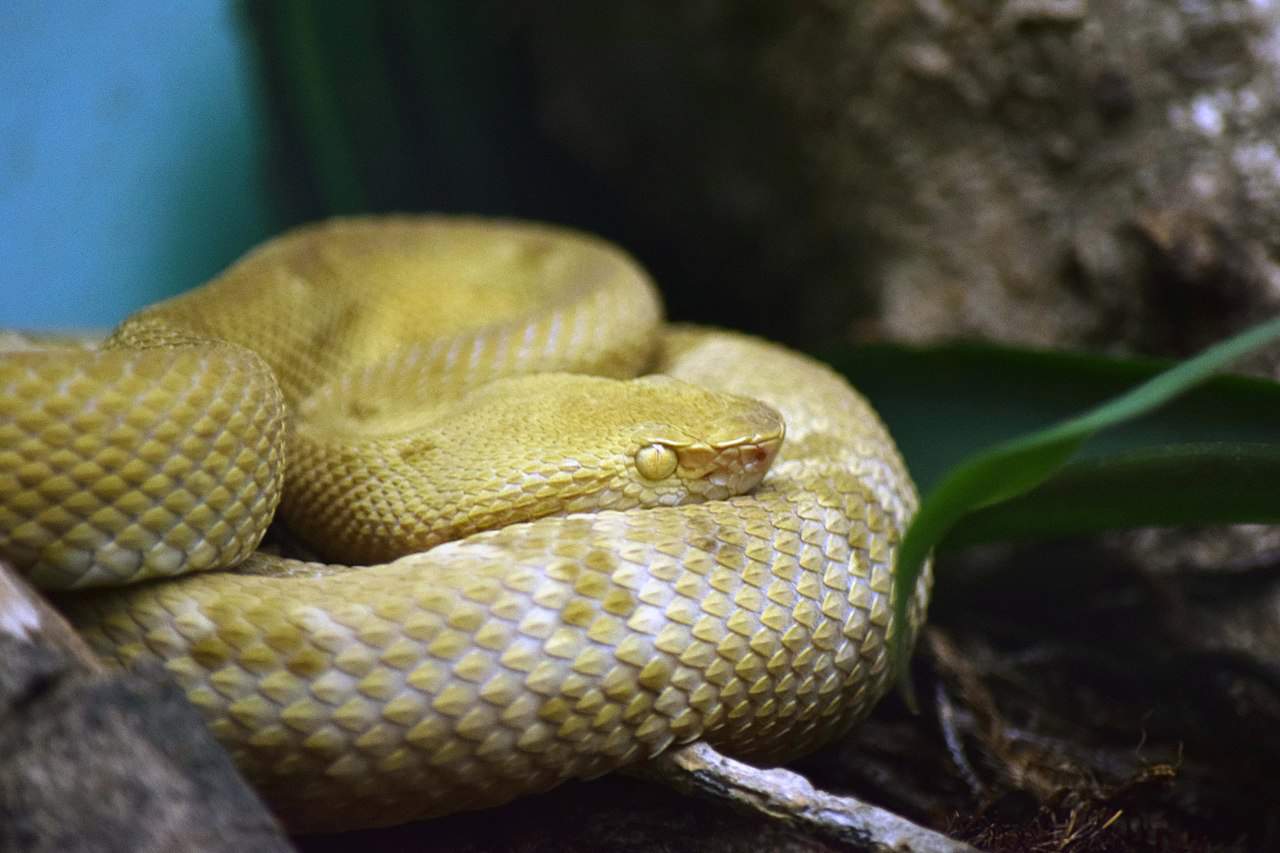
A Brazilian species which lives on just one island: Ilha da Queimada Grande. This is also called “snake island”, as its golden lancehead population is so dense that you can barely move without stepping on one. The island’s snake population is estimated at 3000, and the authorities strongly urge eager explorers in boats to turn back, and just be satisfied with a glimpse of the menacing island.
Living on such a rocky outcrop, the golden lancehead’s diet consists of 83% birds. And to get them, it uses caudal luring: a careful tail waggle which draws curious birds away from the sky, thinking they’ve spotted a worm. Golden lanceheads measure 70-90cm and are strongly venomous, so if the bird gets close enough for a bite, then they’re pretty much doomed. Unlike a green tree python, they can’t slip from their coils at the last second.
Golden lanceheads hide their bodies in bushes against the rocky cliffs. This strategy works best if the snake’s body is hidden. It’s no good if the snake’s tail is waggling mesmerisingly, but the snake’s menacing eyes are right there. Stealth is an essential ingredient for the caudal luring scheme.
| 5 | Eastern bark snake |
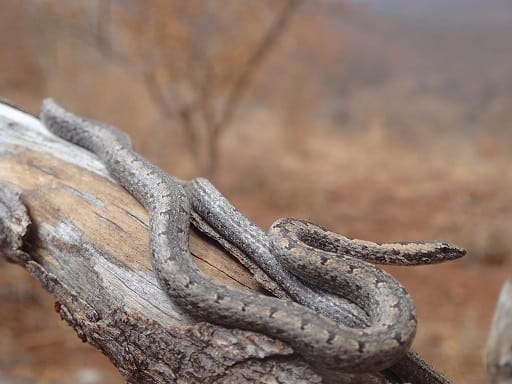
This snake has a bright orange tail, which looks like it could scald you with a single poke, branding you with sinister serpent markings. The real purpose is luring in delicious geckos, one species being the cape dwarf gecko.
This South African species loves to hide in cracks within tree stumps, and rather than forests, they live in tree clumps in mixed savannahs, neither too dry nor wet. They waggle their tail carefully, realising that manic speed is not the answer here. Sometimes no gecko turns up, yet if they succeed, they’ve acquired an easy meal without sacrificing their carefully chosen shelter spot.
Eastern bark snakes resemble a tree branch come to life, adding to the waggle effectiveness. Whether they actually have to concentrate is a mystery. Keeping the waggling at the precise, mesmerising speed might require great mental effort, but it could be purely instinctive, as effortless as a dog wagging its tail. Caudal luring is just another skill snakes have produced as they get more and more bizarre. Snakes first evolved 100 million years ago; fossils have been discovered of them curled around dinosaur eggs. Since then, snakes have diversified endlessly. Some are able to slurp up frog spawn, while others resemble green swinging vines.
| 6 | Malayan pitviper |
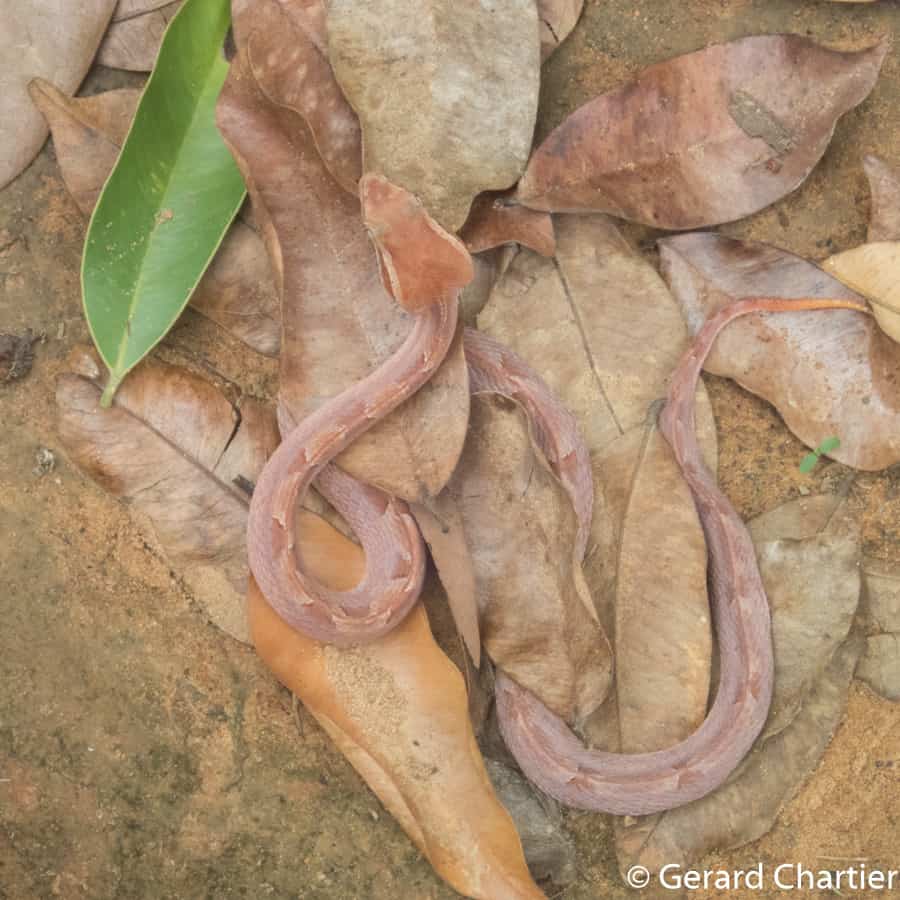
A lizard is starving and hungry. It hasn’t eaten in hours and its reptilian acquaintances are just slightly faster. It looks up, and suddenly it sees an orange dot floating a few metres away. The lizard breathes a sigh of relief, and dashes forward eagerly. The floating dot gets bigger, and at the last second the lizard feels uneasy, but it’s too late, and it is swallowed by a huge pair of serpent jaws. The lizard has just fallen victim to the treacherous ways of the Malayan pitviper (Calloselasma rhodostoma), a pro tail waggler.
The Malayan pitviper lives in Cambodia and Vietnam, lurking in woodlands with an abundant covering of leaves on the floor. Malayan pitvipers can acquire prey via traditional ambush tactics, waiting for prey to walk past. But waggling a colourful tail speeds things up nicely, drawing in potential prey like a tractor beam. The tail is particularly pronounced in young Malayan pitvipers. This species varies in colour – some are pink with an orange tail (see above), while others are dark grey with a white tail.
Fortunately, the nightmare scenario above may not happen, as lizards are nimble themselves, probably with faster reactions than the Malayan pitviper. They can dodge, and even if they fall for the deception initially, their fate isn’t sealed.
| 7 | Green tree python |
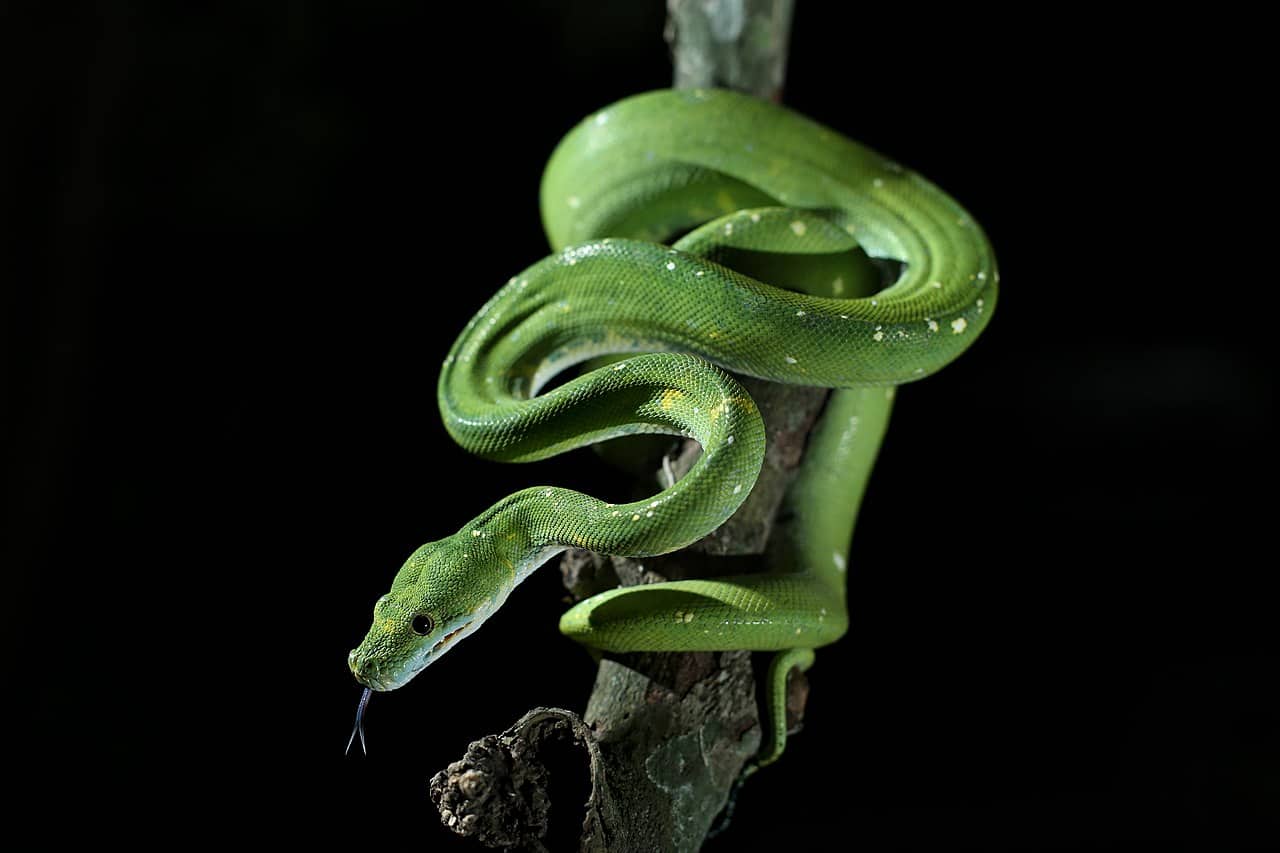
This New Guinea snake is fully committed to the arts of deception. Its colours are geared for camouflage, with bright green overlaid with white markings, which looks like a jungle in snake form. It stays silent when animals approach, hoping to capture them with one effortless pounce. It also has a next generation tail, with a colourful tip that lures in jungle creatures from every direction.
Green tree pythons are popular in captivity, and naturally occur in rainforests and dry forests of New Guinea and Queensland. They have a powerful bite, and species on their menu include Cape York rats. To outcompete their neighbour snakes, which include Papuan ground boas, the green tree python can lure in prey by waggling its colourful tail, using hypnotist methods.
Most importantly, green tree pythons can keep it up for long periods of time. Minutes or even hours of intermittent tail waggling can pass with barely one lizard raising its head. The snake doesn’t weaken from its task one bit. It loses no focus and continues to rhythmically move its tail, knowing instinctively that a lizard will be tempted sooner or later. Experience helps; the more they’ve succeeded in the past, the less they’ll waver.
| 8 | Death adder |
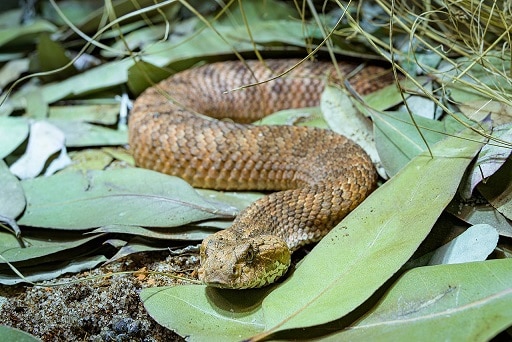
An Australian species which moves its tail at a mesmerizingly slow rate, convincing lizards that they’ve spotted a juicy morsel of food. Death adders are dark grey with beige blotches, and black markings on their face. The final colour is a clean snowy white, found on their tails. It’s equally as important as the other colours; grey is for camouflage at night, while the white is for next level hunting.
Death adders don’t rely on tail waggling exclusively, as they deliberately position themselves in bushes next to well trodden mammal trails, allowing them to spring out. The tempting tail tip is a nice bonus which increases their survival chances by 2%, which might be enough to endure when other species disappear.
Death adders live on bushy trails and forest edges, which have plenty of cover to hide in and execute their waggling schemes. They don’t always succeed though. Failure could be for many different reasons. The lizard might approach at the wrong angle, and see the snake’s hidden body too soon. The death adder might be harassed by a hungry bird while exposed. They might even pick a spot surrounded by white flowers, causing their own colourful tail to be less conspicuous.
| 9 | Bahamian pygmy boa constrictor |
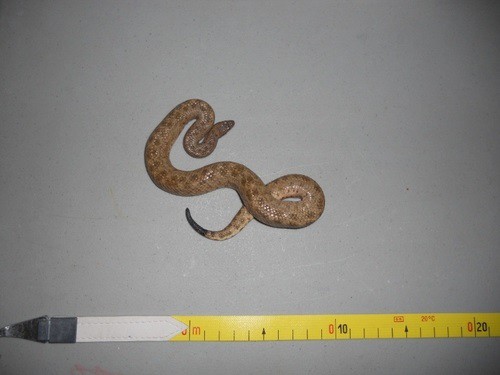
This snake has particularly effective camouflage, meaning that lizards find it all the harder to realise that the bright dot is attached to a hungry body. Bahamian pygmy boa constrictors (Tropidophis canus) measure 30-60cm and are olive with brown blotches. They inhabit both forests and grassy forest edges, avoiding rock fields, as they spend a chunk of their time underground in tunnels.
This species extends its yellow-orange tail (sometimes black) slowly, and waggles it equally slowly. If successful, the anole lizard they lure in can provide enough calories for several weeks, and there’s no need for more strenuous adventures.
This species is native to Great Inagua Island in the Bahamas. Tropidophis canus is harmless to humans, but has a shocking ability to bleed voluntarily from its eyes, as well as deceptive tail waggling.
The strong possibility is that the longer snakes keep their tail waggling schemes up, the more lizards will become adapted. There’s probably a few sharp lizards already who realise that they’ve a glimpsed a serpent tail and not a tasty insect. These lizards will be more likely to survive and spread their genes, and eventually their numbers will rise. A tipping point will be reached where lizards no longer fall for the pygmy boa’s games, forcing the snake to invent new tactics. This scenario might take millions of years, but it’s surely inevitable. In fact, there’s so many lizard species, that a couple may have wizened up already.
| 10 | Lataste’s viper |
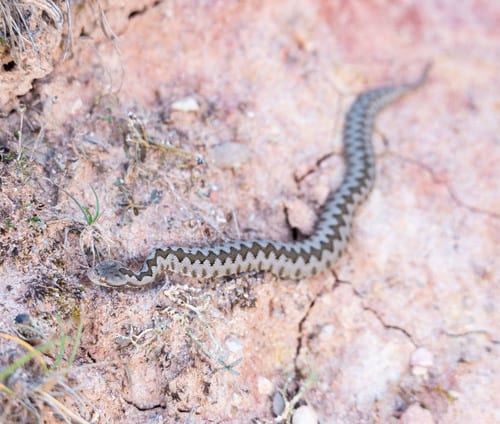
A snake of holm oak forests and rocky slopes in Spain, which varies in appearance. The majority are grey with darker grey zigzag markings, but another chunk are beige against brown. The consistent feature is a neon yellow tail (sometimes pitch black) which looks like it has been dipped in paint. This is perfect for waggling slowly in the hopes that nearby lizards will poke their heads up curiously, and be pulled in like a tractor beam.
Lataste’s vipers are a slow species (except when lunging), which ambushes from bushes and between rocks. They’re unable to cause paralysis, but they do have the power to mimic an insect with their tail. Lataste’s vipers prey on wood mice and Iberian wall lizards, and have no particular grudge against mankind.
Patience is the final key to make the caudal luring strategy work, and the Lataste’s viper has a steely determination. You’d expect that every so often, the snake would get impatient and start waggling its tail 10 times faster than normal. It must be hard to resist the temptation. In fact, most humans would fail just as badly if they were transformed into a Lataste’s viper. The snake has superior focus, doing the thing it spent millions of years evolving to achieve. A human would start well, but grow distracted, absentmindedly checking his watch and then derailing everything, before the entire jungle notices and turns on him.
